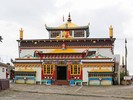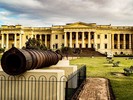Originally known as Makhsudabad, it was reputedly founded by the emperor Akbar in 16th century.In the year 1704, Murshid Quli Khan, one the diwan of Emperor Aurangazeb shifted his provincial head quarter from Dacca to Makhsudabad following the order of the emperor and named it after his name as Murshidabad. He became nawab of Bengal in 1716. The towns flourished on the banks of the river Bhagirathi.Murshid Quli Khan not only secured peace, he also left efficient administrative machinery and an established capital for his successor.The presence of the court, the armyand merchants greatly increased the wealth of Murshidabad. The administrative requirements and the extension of government activities and commerce naturally led to the expansion of the city.
The regime lasts from 1704 to the last Nawab Mirjafar (1760), though it was a small period, the place takes a huge part in the history of India. After the Battle of Palashi (1757), the last independent Nawab Siraj-ud-Daula lost to British and finally the East India Company rule started.
1704 to 1760, Murshidabad has seen the rise and fall of an independent era. Many beautiful sculptures, buildings of endearing nature have been built which attract the tourists even from abroad all the year around.
The transfer of the diwani to Calcutta in 1773 was a blow to the position of Murshidabad as the chief city of the province. By these arrangements the whole power and government of the province was shifted to Calcutta and it became, the capital of Bengal. Apart from this decision of shifting of the power by East India Company, a natural calamity infamous as Great Famine of 1769-70 causes the quick fall to Murshidabad.










